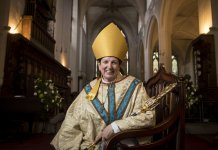Canon Clare MacLaren and Dan Rose of Raskl Art + Architecture introduce the Cathedral’s striking new pieces of furniture, which will now stand at the heart of our Cathedral worship…
Designing and installing a specially commissioned altar and ambo (lectern), together with modern choir stalls to complement this ancient building was an important part of the remodelling project. The new liturgical furniture has therefore been designed to honour the many former generations of worshippers at the Cathedral, but also to leave a lasting and beautiful legacy for future generations.
Now each piece tells a story imbued with layers of religious meaning and is rich in allusions to the history of the Cathedral, our city and the surrounding region. Fortunately, the Friends of the Cathedral were left a very generous bequest, which made it possible for this vision to become a reality.
These pieces were designed to ‘speak to’ and complement the existing medieval font – so that they echoed its sense of permanence and solidity, even though the stalls are easily movable, allowing the choir to sing from various points in the building.

Local expertise and high-quality craftsmanship are showcased in a finished product that is inspired by both ancient and contemporary industries and technologies of the North East – shipbuilding, coal-mining, glassmaking and hi-tech fabrication.
Newcastle-based Raskl Art + Architecture were selected to design and create these unique pieces and there was a constant dialogue of ideas flowing between their team, the Chapter, and the Cathedral’s Fabric Advisory Committee. Raskl’s Creative Director, Dan Rose, steered the process, which culminated in approval from the Cathedrals Fabric Commission for England.
A ship-shaped form quickly began to emerge as the obvious choice for the altar. This connects, of course, not simply with Newcastle’s maritime history and the proximity of the River Tyne but with the Christian concept of the Church
as an ‘ark’ – a place of salvation and sanctuary. Picking up on the geological motif of Newcastle’s mining past, the design of the altar and ambo was based on the idea of a geode, a dull rock which splits apart to reveal a glittering cavern of crystals within. In a similar way, in the ‘breaking of the Word’ at the ambo and the ‘breaking of the Bread’ at the altar, precious treasure
is revealed amidst the ‘ordinary’ of life. The final design is reminiscent of shrines and holy pilgrimage sites throughout the world, and the idea is to provide a sense of mystery, to draw the visitor towards the sculptural pieces, questioning their purpose.
Mimicking the colours of the font, the hand-worked, grey, stone-like outer shell of the pieces contrasts with a rich blue inner layer and each is illuminated, during worship, with the candlelight being a metaphor of huge significance for Christians. The deep blue is echoed in the embedded enamel crosses in the top of the altar and also in the front of the choir stalls. The subtle but powerful wave, deep within the cavity of the altar, is reminiscent of the biblical ‘Calming of the Storm’ and of the Cathedral’s Lantern Tower guiding sailors safely home up the River Tyne. The final designs are humble and sculptural, with a sense of being hewn from natural materials.

The choir stalls themselves have been designed for maximum flexibility so that they can be used in a range of configurations – units of two, four, six and twelve singers. They are constructed from Richlite, an extremely durable laminate made from partially recycled materials similar to Formica, whose European headquarters are in Newcastle.
Along the front of the choir stalls is a representation of a three-dimensional sound wave made up of individually shaped slices of Richlite. The soundwave shape is based on the opening notes of a recording of the Cathedral choir singing Choral Evensong – “O Lord, open thou our lips, and our mouths shall show forth thy praise”.











